Abstract
Using the Wałbrzych agglomeration housing estates—once the most important mining and industrial region in Lower Silesia—as an example, this article illustrates the specific significance of the design of green spaces, including urban layouts, and the issue of protecting unique trees and green spaces in the concepts of estates from the early modernism period after the First World War in the years 1919–1927. This article tries to deepen the knowledge on the origins of the design solutions of public and private greenery systems while considering natural, landscape, and social needs. This study complements the information gathered so far in the field of forming green areas in modernist housing estates and highlights the importance of this issue in complex urban design. The Wałbrzych housing settlements are crucial because they were among the first of their kind, not only in Lower Silesia but also in the whole of the Weimar Republic. Based on literature and source studies, it was possible to reconstruct design ideas concerning the composition of green areas in most housing estates in the discussed area. The most interesting ones were presented and broken down into the landscape-related and functional aspects of the use of greenery in housing estates. This made it possible to select specific solutions applied by designers in order to indicate sources of inspiration and theoretically developed rules which then and now seem to be extremely adequate.
1. Introduction
Modernism is, at times, primarily associated with functionalism and a rationalist approach to design. The first period of this trend remained deeply tied to the concepts that first appeared in the early 20th century. In Germany, the Art Nouveau ideas initiated by Camillo Sitte [1,2,3], the activities of the first heritage protection organizations (Heimatschutzbewegung) [4], and then Howard’s widely discussed theory [5] laid the foundations for design concepts in the first decade after the World War. Modernism provided additional sources of inspiration and indicated new formal interpretations, both urban and architectural [6,7,8]. The postulation to protect the landscape and its natural and cultural values became one of the most important ideological foundations in design. Regionalism of the early modernism period was part and parcel of the landscape and developed the existing compositional rules. Arranging greenery in urban layouts was an important issue. Its special social role was also recognized.
The architecture and urban planning of early modernist housing estates is already a partly researched issue in contrast to the concept of urban greenery of the greenbelt type, which was also developing based on Howard’s visions in the late 1920s and 1930s. However, problem of design greenery—so important for these housing estates—has hardly been taken up (apart from the ecological and conservation aspects [9]) as a leading subject of research [10,11,12,13]. Only the issue of employee gardens (Kleingarten) has received more attention [14,15,16,17]. In a comprehensive study of the housing estates of the Wałbrzych agglomeration in the interwar period, only the issue of the history of design green spaces in residential complexes in the early modernism period was signaled [18] (pp. 584–586). The topic is worth discussing due to the pioneering significance of the housing estate projects in the Wałbrzych (Germ. Waldenburg) mining and industrial district.
By using the Waldenburg agglomeration housing estates an example, this article illustrates the specific significance of the design of green spaces, including urban layouts, and the issue of protecting unique trees and green spaces in the concepts of estates from the early modernism period after the First World War in the years 1919–1927 (see Appendix A, A1). The role of both tradition and innovative research-based approaches to these issues is indicated.
The Waldenburg housing settlements are crucial because they were among the first of their kind, not only in Lower Silesia but also in the whole of the Weimar Republic. The concepts developed during the design process soon spread beyond the borders of the country. This also applied to the development of the principles and methods of composing the greenery of these settlements. Reference was made to tradition, and new or significantly altered forms were introduced. Relevant literature and source studies made it possible to reconstruct design ideas concerning the composition of green areas in most housing estates in the discussed area. The most interesting ones were presented and broken down into those landscape-related and functional aspects of the use of greenery in housing estates. This allowed for the selection of specific solutions applied by designers, the indication of sources of inspiration, and theoretically developed rules, which seem to be extremely adequate both then and now. In addition to the already known and popular forms, the designers used innovative greenery layouts, green street bays, and complexes of communal employee gardens, sometimes also merging into compositions with public greenery. Particularly important was their attitude to the heritage of the past—valuable trees and existing avenues, as well as natural greenery like the surrounding forests, watercourses, and ravines. Greenery systems were used there as both elements of urban composition and as recreational facilities. Carefully considered decisions were successful in that the greenery in the early modernist housing settlements in the Wałbrzych agglomeration still belonged to one of the better designed layouts and could still be a model for contemporary developers of urban plans for residential complexes.
This article tries to deepen the knowledge on the beginnings of solutions in the design of green systems, both public and private, by analyzing this selected object of research. It tries to trace the methods of development and implementation of housing estate greenery systems while considering natural, landscape, and social needs. In this way, it complements the information collected to date in the field of shaping green areas in modernist housing estates, thus indicating the importance of this issue in complex urban planning, as well as in relation to historical natural specimens and existing alley complexes like the greenery of watercourses and ravines.
To this end, the basic premises for the emergence of new housing concepts in Germany in the early 20th century were characterized. The significance of housing estates in the Walbrzych region is discussed against the background of the history of housing estates in the Weimar Republic. In the main part of the paper, three separate categories of shaping green areas in residential complexes of the Walbrzych agglomeration are presented: (a) the landscape, (b) the composition of the role mainly played by public greenery, and (c) the socioeconomic category related to the planning of home and working gardens. The discussion pointed to the special treatment of greenery design in the planning of modernist housing estates and a comprehensive approach to this issue.
2. Materials and Methods
The study was based on the research method used in the humanities that required an analysis of the background of the phenomenon; a study of available sources, research, and analysis of the subject matter; and an attempt to create a synthetic comparative characteristic. The historical background was characterized in relation to the problem of the architectural and urban design of housing estates of a selected period in Germany and Silesia. A full review of the scientific literature on the selected research subject was carried out. All available archival documents—designs, maps, drawings, photographs, and written reports preserved in the State Archives in Wrocław (Archiwum Państwowe we Wrocławiu (APW)) and its branch in Kamieniec Ząbkowicki (APW Kamieniec), as well as the collection of the Porcelain Museum in Wałbrzych—were analyzed. Local press (especially regarding those stored in the collection of the Walbrzych Museum) and professional press (especially the Schlesisches Heim magazine) queries concerning the aspect of design and implementing greenery systems in the housing estates of the Walbrzych region were carried out. Field research was carried out, and up-to-date reports on the state of preservation of the presented greenery in the housing estates were found. The study of urban planning and architecture of the Wałbrzych agglomeration settlements had been carried out by the author since 2000. In recent years, this was supplemented by a search for archival documents from private collections (mainly iconographic) made available on websites, as well as subsequent local inspections of the changing resources. In 2020, materials relating to the issue of greenery design in the surveyed housing estates were completely gathered. Based on the study of the available scientific literature and sources, it was possible to reconstruct design ideas concerning the composition of green areas in most estates of the selected period in the discussed area. This article presents the most interesting of them, grouping them according to the landscape and functional aspects of the use of greenery in housing estates. This made it possible to select specific solutions applied by designers and indicate sources of inspiration and adopted rules reported in the professional press.
3. Ideological and Historical Background
3.1. Early Modernist Housing Estates—From Art Nouveau to Regionalism
In the period before and after World War I, the immediate environment began to play an increasingly important role for the Art Nouveau artists. Criticism of the artificiality of classical and historical patterns in relation to the designs of the historicist period also began to include the inspirations of early Art Nouveau derived from Gothic and Far Eastern art. In Germany, this manifested itself in the form of a mental and cultural movement. Its slogan became the protection of national heritage (Heimatschutzbewegung). Breslau became the seat of the organization Schlesischer Bund für Heimatschutz. Its founder Hans Poelzig and Max Berg, an important activist, were teachers and mentors for younger architects [19,20]. Thanks to their involvement, the design trend spread in architectural literature and academic teaching. The interest of Art Nouveau artists in the Middle Ages and their fascination with nature led them to perceive the value of historic buildings not only in their individual form but also in combination with their surroundings. The emerging principles and institutions of conservatory protection also drew attention to the issues of landscape protection together with its natural values. These problems were included in theoretical and design architectural considerations, in which the planning of green spaces came to the fore.
Ebenezer Howard’s book played a special role in integrating greenery arrangement issues into urban design [21,22]. In the spirit of Art Nouveau, Ebenezer Howard tried to develop principles combining the advantages of urban and rural life. The solution was found in the decentralization of cities by creating a network of self-sufficient garden-cities surrounding the superior center. These postulations were partly put into practice in Lower Silesia by building villa districts near cities, e.g., Wrocław (Breslau, Kleinburg, 1872–1900), then suburban garden settlements and districts in Wrocław like Gartenstadt Bischofswalde (1908–1911) and Gartenstadt Carlowitz (1911), and other cities like Neustadt Waldenburg (1904), Gartenstadt Neisse (1911), and Gartenvorstadt Liegnitz (1911) [23,24,25,26,27].
The competition for the development of Great Berlin in 1910, the international urban planning exhibition taking place at the same time (Berlin, Germany, 1910)—as well as the Town Planning Conference in London organized by the Royal Institute of British Architects (1910) [1] (p. 57)—provided an opportunity to lay down final principles for the planning of modern cities. Among the new ideas were polycentric town planning, the separation of new development by green belts and wedges of greenery, and the zoning of urban development, all of them referred to Ebenezer Howard’s idea of the “garden city”.
The Green Manifesto (1918) of Leberecht Migge [28], already a well-known landscape architect at that time, became the last decisive element for the formation of a program for improving the functionality of estates of the interwar period in Germany. Migge advocated solving the social and economic problems of the German people by creating gardens, parks, and (first of all) small vegetable gardens (200–400 m2) to supplement food and to improve the climatic qualities of residential areas [28,29] (pp. 8–20).
3.2. Attempts to Solve the Housing Problem in the Weimar Republic, Lower Silesia, and Lower Silesian Coal District after World War I
After the First World War, the Weimar Republic created a favorable situation for the development of the theory and practice of housing estates design. On the one hand, the housing shortage due to industrial development and war damage was desperate; on the other hand, a favorable political climate was created for attempts to solve this problem. Power passed into the hands of social democrats. Their program included the improvement of living conditions of workers and civil servants. Apart from efforts to improve working conditions, the housing program became an equally important element of the government’s social policy [30]. Immediately after the war, on the basis of the idea propagated in Germany by Leberecht Migge and Hermann Muthesius [31], the authorities developed the concept of housing development that consisted of erecting Kleinsiedlung—small housing estates with home gardens [32,33,34]. Legal tools that allowed for the launching of economic and social mechanisms were applied (see Appendix A, A2). In 1918, the first communal housing cooperatives (gemeinnützige Baugesellschaften) were established [30].
In July 1919, the company Schlesisches Heim (Schlesische Heimstätte) (see Appendix A, A3) was founded in Silesia [18] (pp. 243–246) [35,36,37]. Its aim was to erect cheap, small houses for workers and civil servants in suburban settlements and to build rural settlements near towns and villages. The urban and architectural program of these settlements was initially run exclusively by Ernst May (A4). He also outlined a general vision of these developments [38,39,40,41]. In his vision, the city of the future was to have a center with high dense buildings, on the periphery of which small settlements of detached houses would be built and then connected to the main center by efficient public transport. The urban and architectural concepts were to draw inspiration from the layout and development of the Silesian countryside. May proposed complexes of scattered, street-based, and oval-village-shaped settlements concentrated around a village green (Streusiedlung, Strasensiedlung, and Angersiedlung), depending on the local landscape conditions and needs [42]. Apart from flower and vegetable gardens, the buildings were to be surrounded by greenery planted around squares and streets. With time, however, the activities of the Schlesische Heimstätte company dominated the housing market in the construction of suburban settlements. It operated in 22 town districts, and it cooperated with the administration of towns and municipalities (especially suburban ones) and with local companies and societies [42,43].
The region of the Lower Silesian Coal District (Niederschlesischen Steinkohlbezirk), and Waldenburg itself (now Wałbrzych), the second largest city in Lower Silesia, was suffering from the greatest housing shortage on a national scale [43] (p. 74) and was the first, in a sense, experimental area of May and the Schlesische Heimstätte company’s activity. In a short period of time, thanks to the efforts of the administration, party, and trade union activists, a mining housing fund (Treuhandstelle für Bergmannswohnstätten in Niederschlesischen Steinkohlbezirk) was established with its seat in Salzbrunn (Szczawno Zdrój) [43,44] (p. 91) [45,46], which cooperated with construction companies and communal cooperatives to facilitate the financing of investments. In initial cooperation with local mining and industrial tycoons, first of all with Fürsten v. Pless Consolidierte Fürstensteiner Gruben and later with communal companies, the Silesian organization Schlesische Heimstätte erected more than twenty housing estates between 1919 and 1924 in Waldenburg, Gottesberg (now Boguszów)—two towns of the mining district and several neighboring communes. Land for the construction of housing settlements was purchased and 815 flats were erected, financed from the funds of the district and the state (5.8 million marks from the state mortgage and 1.9 million from other sources) (see Appendix A, A5) [43] (p. 95). In the following years, the acceleration of works on the erection of communal settlements was significantly influenced by the Act of 1924 on rents [30] (p.251) that, by increasing the fee for mortgage charges, provided an additional source for the construction of new flats. In the years 1924–1927, a further 1353 residential premises were built in the Waldenburg area.
4. Results
4.1. Greenery in Panoramas and Views from Housing Settlements in the Waldenburg Area
The hilly and mountainous terrain of the Waldenburg area made it possible to create special landscape effects. Housing estates were built at the foot of towering peaks—small ones like Wilhelmshöhe (Gediminas Hill) and quite impressive mountains like Schwarze-Berg (853 m above mean see level, Borowa) or Hochwald (850 m, Chełmiec)—and on the edge of old villages and developing mining towns (usually neighboring with vast areas of private forests that were mostly owned by the Hochbergs but sometimes owned by the state. The artists were perfectly aware of the possibility of exploiting the landscape values of the area. Ernst May knew the surrounding mountains and villages and made sketches of them in his sketchbook (see Appendix A, A6). Most of these settlements were created as special landscape complexes. They were created as separate units that were carefully integrated into their environment. This was manifested in the conscious and extremely careful shaping of the panoramas of the complexes. This problem was raised, among others, by May himself when discussing the issues of housing estates design. He emphasized the necessity of subordinating an urban complex to a dominant feature. In most cases, these were already existing church towers in neighboring villages. This is how the housing estate in Gottesberg was designed. In the settlement Stadtparksiedlung (Gaj), a chapel was to be built as a dominant element. The housing estate on Sandberg (Piaskowa Góra) in Salzbrunn was subordinated to the dominant of the Catholic church, and the housing estate in Dittersbach (Podgórze) near Waldenburg was subordinated to the dominant elements of the Lutheran church. The designed housing estates were adapted to the existing development method in the neighborhood, its intensity, and the height of the buildings; they received similarly shaped composition nodes and a dilution of the building fabric in the form of squares and street extensions. This created an analogous urban pattern that imitated the spontaneity of the settlements’ development in the landscape. The settlements built by or in cooperation with Schlesische Heimstätte show that the best results were achieved when the topography was preserved and followed. Small slopes, escarpments, or depressions gave the settlements a natural and picturesque landscape. The location of settlements on hills or slopes gave views of the surrounding panorama.
Hermann Jansen (see Appendix A, A7) took particular care to exploit these opportunities [47,48]. When, after the First World War, the city authorities of Waldenburg independently made another attempt (after the foundation of Neustadt; Nowe Miasto) to build a large residential district, they asked this well-known Berlin academic for a design. In the arrangement of Hartebusch Siedlung in Waldenburg, Jansen repeated the principles of spatial organization used in the Berlin housing estates of his design; see Figure 1.
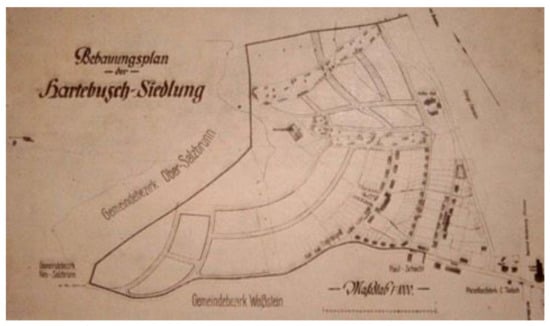
Figure 1.
The project of the housing estate Hartebusch (part of Stary Zdroj in Wałbrzych). Original version developed by Hermann Jansen. From [44] (p. 91) (Public domain), https://www.dbc.wroc.pl/dlibra/publication/3031?language=pl (accessed on 7 January 2021).
However, the specific topographical conditions dictated special solutions. Due to a shortage of land in the neighborhood of Waldenburg, it was decided to locate the housing estate on this exceptionally steep slope. This imposed a kind of terraced layout on the whole settlement; see Figure 2.
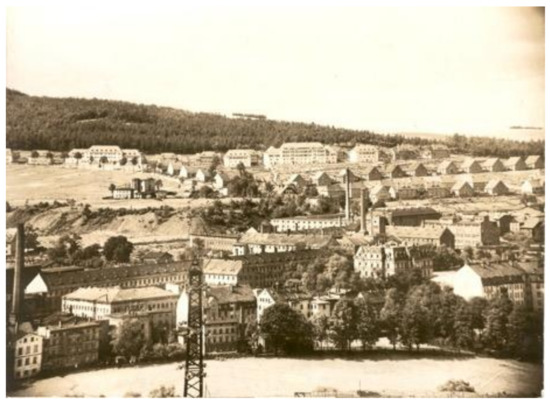
Figure 2.
The housing estate in Hartebusch Siedlung (Stary Zdroj in Waldenburg) at the time of construction. Adapted with permission from collection of Historical Department of the Museum in Wałbrzych (Muzeum Porcelany w Wałbrzychu, Oddział Historyczny) 2505.
Along the main road, the estate was enclosed by a row of multi-family buildings. Along the main streets, the composition nodes were regularly arranged in the form of squares and terraces connected with the largest three-story multi-family houses, from which one could admire the panorama of Waldenburg and Altwasser (Stary Zdrój, Jastrzębie-Zdrój, Poland) [18] (p. 247–264).
Perhaps it was this successful settlement that inspired Ernst Pietrusky (see Appendix A, A8) [49,50,51] to shape a similarly situated settlement in Nieder Hermsdorf (Sobięcin Dolny); see Figure 3a. Unfortunately, most of the planned viewpoints were not completed. The project of Ernst Pietrusky’s housing estate in Nieder Hermsdorf was selected as a result of a contest announced in the magazine Schlesisches Heim [37] (pp. 8,68,111) [52,53,54,55]. The architect based his conception on a strict representation of the terrain’s shape; the irregular lines of the streets were running horizontally. Probably this naturalness and the use of a high building density for a housing estate of this type were decisive for the choice of this solution. As in the case of the settlement on the slopes of Wilhelmshöhe in Hartebusch Siedlung, squares were to play particularly important role in the layout of the Nieder Hermsdorf housing estate, including appropriately placed squares at the end of the streets in the form of viewing terraces opening onto the valley of the stream flowing through the village.
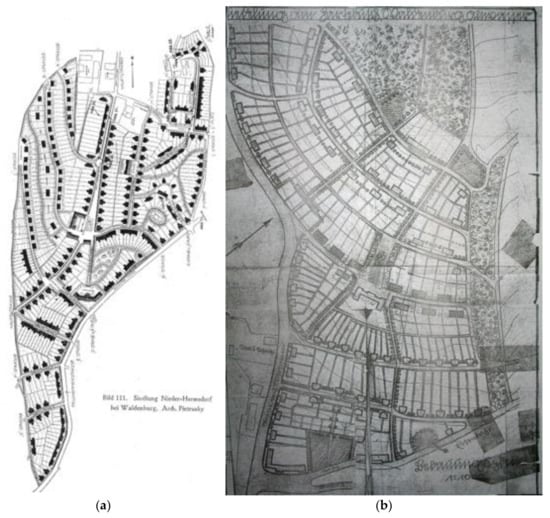
Figure 3.
(a) The project of the housing estate in Nieder Hermsdorf (Sobięcin Dolny) developed by Ernst Pietrusky; from [37] (Public domain), https://www.bibliotekacyfrowa.pl/publication/37009 (accessed on 7 January 2021). (b) The project of the zoning of the settlement Hartebusch on the slope of Wilhelmshöhe (Stary Zdrój) made in the municipal office of Waldenburg. Reproduction without scale. Adapted with permission from collection State Archives in Wrocław, Branch in Kamieniec Ząbkowicki, Acta specialia des Magistrat zu Waldenburg, No. 21, p. 6, Siedlung am Hartebusch, Waldenburg Altwasser, Stadtbaurat, 1:1000, no year. (after 1920).
The early modernist housing estates of the Waldenburg agglomeration were formed as unique landscape complexes that were carefully inscribed into the mountainous landscape of the region. Subordinated to selected dominants, with carefully shaped accents in height and volume, they revealed themselves in interesting panoramas and views. They were enclosed by greenery that separated them from the neighboring areas. Viewing points were planned within the residential complexes, where views of old villages, mountains and hills were given between the houses and rows of trees. Inside the housing estates, green alleys and gardens surrounded the buildings, separated the sub-units, and contributed to the compositional skeleton.
4.2. Greenery in the Settlements: Squares, Green Spaces, Tree Rows and Alleys
In the design of this period, the role of public greenery was appreciated, both in larger areas in the form of parks and huge squares and in the form of street rows.
On the Hartebusch estate, Hermann Jansen, in his typical fashion, used green strips to separate the different levels of the housing to accentuate the main public spaces and to emphasis the composition. Between the two main streets, which run horizontally from side to side, a green public area with squares and playgrounds was laid out in the middle of the estate. They constitute the skeleton of the settlement, which is emphasized by the grouping of multi-family buildings and the creation of a green space between them, Eichenplatz (i.e., Oak Square, now Zawisza Czarny Square), where the architect decided to preserve the centuries-old oak trees. Below the two main streets, two levels of parallel streets were designed, and above the main streets, one was designed. To the north, at the end of the streets, Jansen planned to leave a green belt in a shallow ravine, subordinated to the compositional axis created by the water tower visible over the housing estate. On the other side of this green space on the north-eastern slope of the hill, he designed the second part of the housing estate in a similar terraced arrangement.
Another version of the project was prepared by Otto Rogge (A9]) (Figure 3b), a building advisor at the municipal office [18] (pp. 18, 247 et seq.) [56]. He took even more care to preserve the existing valuable trees and arrange new plantings along the estate streets. The lower main street of the estate, the original village road, is lined with rows of lime trees; see Figure 2 and Figure 4. In the highest part of the settlement, there is a large square called Buchenplatz (i.e., Beech Square or Gediminas Square), where beech trees are protected. All squares and plazas of the settlement were connected to extremely steep pedestrian walkways that are, in some places, arranged as stairs running up and down the hill. At most of them, tree rows were designed to highlight their course. The architectural lines were also planned to be highlighted by connecting the free-standing buildings with rows of trees. From the first stage of construction, tree rows were planted along the streets; for this purpose, specific species were chosen, e.g., the lime alley was supplemented with faster-growing chestnut trees. The centuries-old oak trees were preserved, but the beech trees were unfortunately partly cut down.
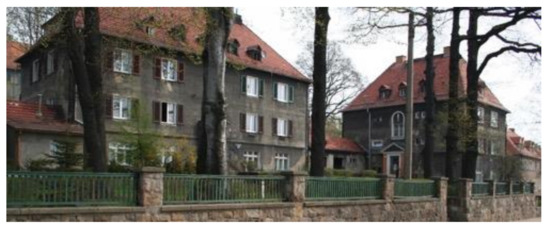
Figure 4.
The housing estate in Stary Zdrój in Wałbrzych (Hartebusch Siedlung). The lower main street (Żeromskiego Street) of the estate (the original village road) lined with rows of trees. Photo by the author in 2009.
In the arrangement of the greenery, familiar forms of rows, avenues, and squares were used, sometimes extending like a small park. The special role assigned to the greenery was different. In the final effect, the housing estate gained a system of greenery, co-creating the basic urban composition. Successive lines of buildings on the slope were separated by strips of greenery that formed a background for them. The rows emphasized the rhythm of the urban structure. The green spaces stretching down the slope and continued by the trees on the steep pedestrian approaches were used to emphasize the main compositional axes of the urban complex.
Ernst May had a slightly different approach to the design of the green spaces in the neighborhood when he planned the housing settlement—Stadparksiedlung [18] (pp. 280–290); see Figure 5.
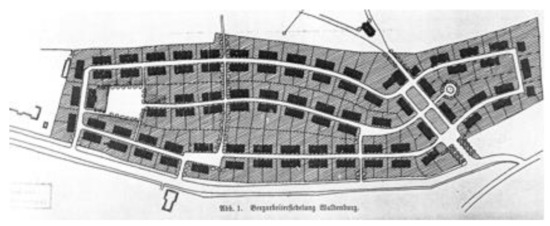
Figure 5.
The project of the settlement Stadtparksiedlung in Waldenburg (Gaj in Wałbrzych) developed by Ernst May. Adapted from ref. [45] (p. 3). (public domain) in collection of Wrocałw University Bibilotheca.
It was to be a residential complex reminiscent of the villages near Waldenburg, with buildings appearing to be spontaneously developed. The greenery introduced into the layout had to emphasize this character by creating groups of trees and bushes reminiscent of those spontaneously growing by the roads and main squares of the village. The concept of the settlement resembled the construction of Neustadt or the settlement Hartebusch—the creation of a completely independent urban organism. The land to be developed was located behind a mountain railway viaduct that was far from the town and surrounded by forests on all sides. The solution proposed by Ernst May took the shape of the land into consideration (levelling was kept to a minimum). The two main roads run inside the area along a closed lenticular circumference. Small, semi-detached, single-family houses were designed on both sides of the streets. The plots marked out on both sides have a variety of shapes. The main square, as well as several small squares inside the settlements, was planned. The complex was made to have charming alleys. There is no rigidity, there is variety, and each section has a different curve due to the terrain. The narrow streets are winding, almost like country paths. Diverse groupings of buildings were created around squares, and accents and compositional nodes were created despite the use of identical architectural objects. The complex is an example of implementation of the “garden settlement” concept in the form of a village-like unit with greenery that imitates groups of natural vegetation. The idea was based on the creation of a small semi-rural center—a square with a school and a chapel in the north-eastern part (from the town side), closed on two sides with two-story frontages, with passages in the that which could satisfy the needs of the inhabitants. It also had its advantages in terms of the landscape. The introduction of the square created a hierarchy of space and gave independence to the settlement that was thus gaining a rank equivalent to the neighboring industrialized villages [45,57,58]. Both the main square and all small squares of the settlement were filled with greenery, though some of them only with low levels of such. However, the basic greenery in the settlement was planned to be private fruit and vegetable gardens with flowers, thus creating a rural landscape. The greenery complemented the buildings, and together they formed a housing unit that very closely copied the appearance of the neighboring medieval villages.
It was also possible to combine these two ways of using greenery of traditional composed forms and imitation wild vegetation. In the unusually careful design of the Nieder Hermsdorf settlement (Figure 3a), Pietrusky was inspired by both the propositions by Jansen and some of May’s ideas in the design of the greenery. The concept was based on keeping a road connecting an orphanage (which had been erected in the former village at the end of the 19th century) as the main street, with a folk house designed in the southern end of the settlement on a hill, to which a line of stairs in greenery would lead; this settlement was to be preceded by a triangular square that constituted the settlement’s main square [37,55] (p. 68). Ernst Pietrusky planned three-story buildings with commercial premises on the ground floor. Thus, the square was to constitute the functional and spatial center of the settlement. The remaining streets were laid out along curve lines in accordance with the slope’s contours, crossed with streets running down the slope of the terrain [54]. The irregular course of the streets introduced diversity and a high individualization of space, despite the use of typical buildings. The use of small squares was to highlight the rank of selected objects, and, in the final version, it was used to create distinctive places where the life of the settlement would concentrate.
The housing settlement was conceived as a compact and closed urban layout whose composition was based on emphasizing the main axis, within which the center of the housing settlement—clearly marked and emphasized with the use of higher buildings—was developed. The streets and narrow pedestrian passages were to be planted with tree rows. Numerous green squares enriched the layout. In the eastern part of the settlement, at the foot of the slope, a rectangular elongated square was planned with a small square connected to it at the corner, and an irregular square in the bend of the street was planned to be above it. In their vicinity, at the crossroads of the streets, a small rectangular square was to be the foreground of the kindergarten and school building. In the original version, another large rectangular square with a bay was planned at the south-western end of the settlement, as were squares at the ends of the streets on the western side—one of them with a viewing terrace. There were also to be two large squares on the settlement, a kind of small park sheltered by a screen of trees. They were located within the quarters of single-family housing on large plots extending the public greenery with private gardens; see Figure 6.
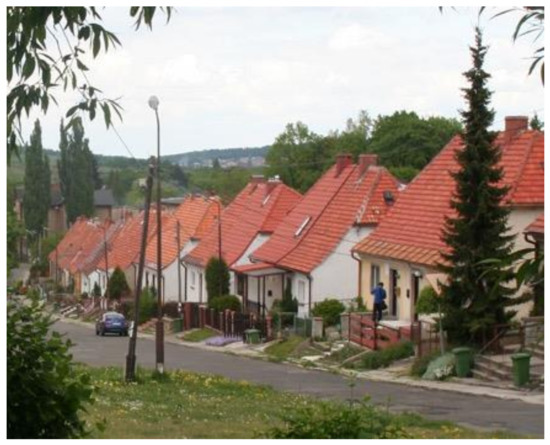
Figure 6.
View of Kresowa Street in Sobięcin (Nieder Hermsdorf). Photo by the author in 2010.
The larger of the squares was adjacent to the steps leading up to the folk house on the settlement’s main traffic route. The project was not fully implemented. However, during construction, the greenery in the settlement was introduced from the beginning in accordance with the plans of project. Lime, maple, and chestnut trees were planted along the streets. Some of them also appeared in private front gardens introduced here [59]. As in Hartebusch Siedlung, a lime-poplar alley [60], which ran in the neighborhood and was later supplemented with maples and old pines on the top of the hill, was preserved. A centuries-old yew tree at the northern end of the settlement was also treated with due respect. In 1925, the 19th century park (Volks Park) in the north of the settlement was redesigned. Within several years, the settlement became a green enclave, which, of course, did not reduce the health problems of its residents. From the very beginning, the biggest inconvenience for the housing settlement was the extremely close vicinity of the coking plant and chemical works. Already in the 1920s, the planners working on this housing estate addressed queries to the local authorities about the acceptable rates of air pollution in the residential areas due to the proximity of the coking plant and the chemical works [61]. It is possible that the Nieder Hermsdorf settlement was one of the first places where the issues of industrial pollution started to be addressed.
The greenery system of the Nieder Hermsdorf estate co-created the compositional skeleton of the residential complex. It marked the main compositional axis and emphasized the most important urban interiors. The park with a garden restaurant, amphitheater, and music pavilion, as well as spacious green squares, provided areas for rest and recreation. Green front gardens in front of the service buildings and kitchen gardens created a compact green environment for development. Particularly interesting was the incorporation of private gardens into an overall ensemble with green areas accessible to the public and decorated with lines of footpaths. This created an impression of the naturalness of the greenery planted on the estate. Another important aspect was the respect for the existing trees and the park complex, as was the case on the Hartebusch estate.
Similarly shaped green squares, parks, streets, and alleys were designed in other housing settlements built in the region of Waldenburg in cooperation with Schlesische Heimstätte. Squares, some of which were to be planted with trees and others of which were only to be planted with low greenery, were an integral part of the layout. In the settlement planned as an extension of Gottesberg (1919), Ernst May, apart from the square functioning as a market, also designed a triangular green square in the middle of the development surrounded by single-family terraced houses [62]. In the competition-winning design of the housing settlement in Neu Salzbrun (Nowe Szczawno) (1920), Theo Effenberger, already a well-known designer from Wrocław and the author of the housing settlement in Pöpelwitz (Popowice in Wrocław) (1919) (A10]) that was under construction at that time [63,64], introduced an irregular square surrounded by compact building frontages at the end of the axis of the layout—a street emerging from the former communication junction in front of the railway viaduct [18] (p. 357) [65]. In the second of the settlements planned in Rothenbach (Gorce) for the Schlesische Kohlen und Kokswerke company, May and his teammate Bussmann proposed a square in the center with a semi-circular outline, a school, and a church (or folk house?), surrounded with a park (1921) [66]. These complexes were not realized. In Weiβstein (Biały Kamień in Wałbrzych), the designers chose solutions with squares in the center of the housing settlements divided into workers’ gardens (1924) (see Figure 7) [18] (pp. 325–337).
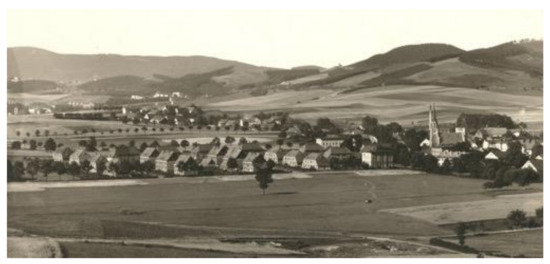
Figure 7.
View of housing estate of Weiβstein (Biały Kamień) in early 1920s. Adapted with permission from collection of Historical Department of the Museum in Wałbrzych (Muzeum Porcelany w Wałbrzychu, Oddział Historyczny) 2881.
Squares were important green elements used in early modernist housing estates. They took a different form than those from the 19th and early 20th centuries. They often had an outline of an irregular triangle or were not of any size at all. They accompanied not only important service buildings but also often diversified residential developments, including single-family ones. This type of solution imitated natural groups of vegetation.
Tree rows were equally important for composition. In the case of the housing settlement in Sandberg (1918–1919), rows of lime trees and chestnut trees on both sides of the street constituting the basis of the complex emphasized its character; see Figure 8. Using a cul-de-sac, which resembles an agricultural homestead, it skillfully imitated the development of a typical mountain village stretching along the green banks of a creek [67,68]. The housing settlement in Gottesberg was enriched by street bays with rows of lime, maple, and chestnut trees; see Figure 9. In the above-mentioned Effenberger’s project, the compositional skeleton was to be the ring street (Ringstrasse), with a one-sided development on the outer side of the housing complex surrounded by a tree row, from which the Salzbach (Szczawnik) valley would be visible; on the other side, the housing settlement on the Hochwald Mountain would be visible. On both housing settlements in Dittersbach (Podgórze in Wałbrzych)–Neuhäuser Siedlung and Melchior Siedlung (1920), which was designed by Ernst May and adapted in the municipal office by Daehmel [18] (pp. 291–311) [69,70,71,72,73]—one could enjoy the views of grand alleys. At the Melchior shaft (after the war, it was renamed the Mieszko shaft), these were lime alleys on both sides of the railway tracks (Figure 10), while at the second settlement, the old lime alley (Neuehauser Allee) was preserved, running from the village near the Catholic church up the slope towards the castle and the manor in Neuhaus (Nowy Dwór) (Figure 11). Like in Nieder Hermsdorf, front gardens separated by rail fences and rhythmically planted trees appeared in front of the houses in both these settlements. They were also created in subsequent small settlements in Konradsthal, Nieder Salzbrunn, and Adelsbach near Waldenburg (Konradów, Szczawienko, and Struga) (c. 1923–1925) [18] (pp. 358–377).
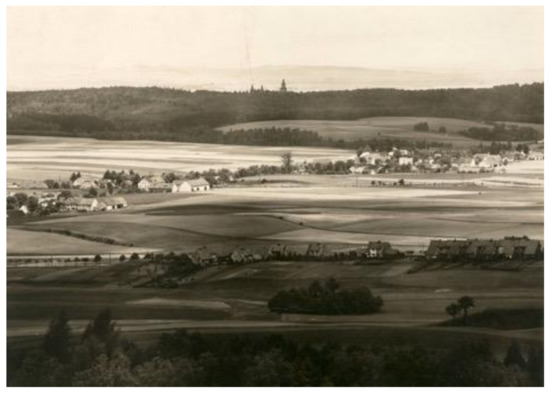
Figure 8.
View of settlement on Sandberg (Piaskowa Góra) and Salzbrunn (Szczawno) in the interwar period. Adapted with permission from collection of Historical Department of the Museum in Wałbrzych (Muzeum Porcelany w Wałbrzychu, Oddział Historyczny) 2877.
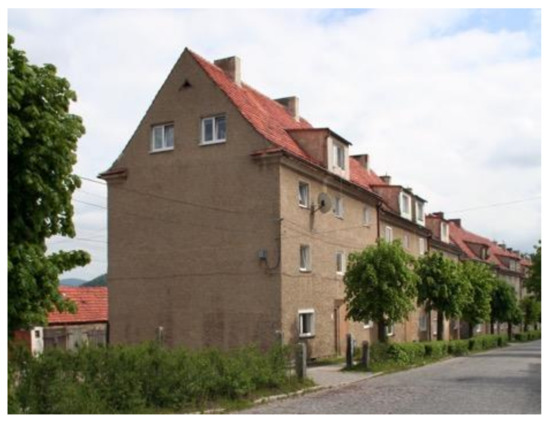
Figure 9.
View of housing estate in Gottesberg (Boguszów). Ulica 1 Maja (Street of 1 May) with rows of lime trees. Photo by the author in 2015.
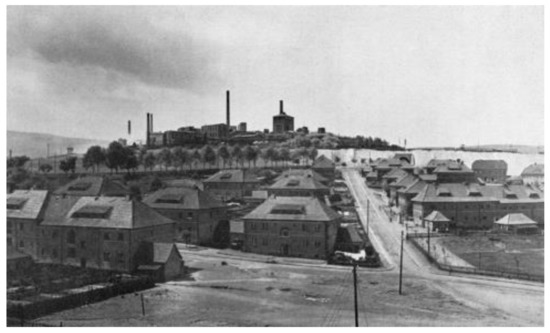
Figure 10.
View of Melchior Siedlung in Dittersbach (Podgórze in Wałbrzych) in early 1920s. Adapted with permission from collection of Historical Department of the Museum in Wałbrzych (Muzeum Porcelany w Wałbrzychu, Oddział Historyczny) 2877.
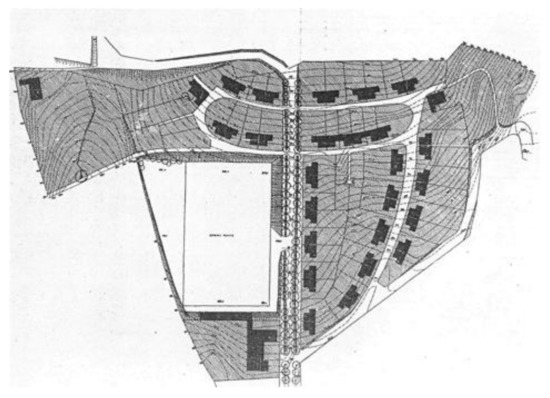
Figure 11.
The project of Neuhäuser Siedlung in Dittersbach (Podgórze in Wałbrzych) developed by Ernst May. Adapted from [70] (public domain).
Avenues and rows of trees, both the preserved and carefully protected 19th-century complexes and the new ones, constituted an important element of the urban composition of the residential complexes under discussion. In this case, as in the design of the squares, in addition to continuing the form of a straight avenue and row and a regular roundabout, planting in the form of short rows, which were non-rhythmic in character and imitated natural trees, was sometimes used.
The preservation of some green spaces within the designed housing settlements was also required for reasons of economy and knowledge of the influence of physiography—the topography of the terrain, the presence of watercourses, sun exposure, problems with cold air flow, and ventilation. This could already be seen in the earliest post-war project by Jansen, where the architect left green ravines that were difficult to level and are threatened by cold air flow. Similarly, he approached May’s physiographic issues with great emphasis, probably largely influenced by Raymond Unwin. In mountainous areas, the consideration of rules was particularly important, which he highlighted in his articles. A characteristic feature of his projects was the precise adaptation to topographic and physiographic conditions. Taking advantage of the terrain’s shape in addition to improving the microclimatic values, significant savings on levelling works during construction usually resulted in a smooth curvilinear line in the urban composition [66]. Consequently, the settlements had small interiors, and the inhabitants enjoyed various views from successive places along the streets. In the Waldenburg region, the settlements built in this period, usually in difficult-to-develop areas with steep slopes, were given a layout based on running streets parallel to the slope contour. In the case of the Dittersbach housing settlements, the main streets were laid out in wide arches that formed serpentines and horseshoe shapes surrounding green spaces. In May’s designs (Stadparksiedlung), attention was drawn to the extremely precise mapping of the terrain along the streets, which were thus laid out along a winding line. A completely new theoretical problem was the design of settlements on steep slopes (Rothenbach) [66]. May drew on limited design experience to solve housing estates in mountainous areas. There were no patterns of regular village buildings, so he drew some inspirations from the towns of the Sudeten foothills, e.g., Silberberg (Srebrna Góra) [73] and probably also from Gottesberg (which Ernst May known from the time of design). He developed a layout following the contours of the hill, with farm buildings at the gables of the houses or in a separate line at the back of the plot.
In the design of early modernist housing estates around of Walbrzych (Figure 12), public greenery was of particular importance. It was arranged in a way that imitated the forms existing in the landscape. Old alleys were preserved, and the design of this form of greenery, clearly visible in the landscape, was continued. This emphasized the traditional communication and cadastral structure. Tree rows served to strengthen the rhythm of the buildings. Larger greenery complexes marked the axes and composition nodes of these urban layouts. At the same time, many elements imitating natural groups of roadside and village greens were introduced. They gave the whole arrangement a character of spontaneity.
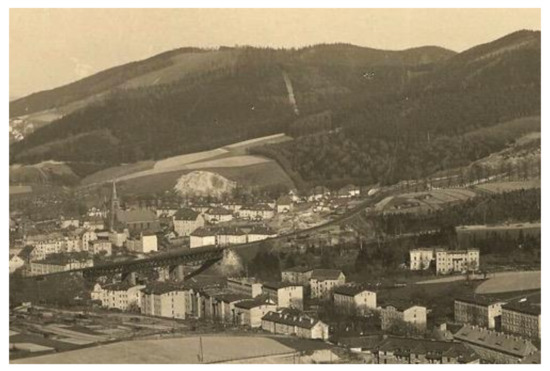
Figure 12.
View of Neuhäuser Siedlung (behind the railway overpass) in Dittersbach (Podgórze in Wałbrzych) in the interwar period. Adapted with permission from collection of Historical Department of the Museum in Wałbrzych (Muzeum Porcelany w Wałbrzychu, Oddział Historyczny) 3085.
4.3. Employee Gardens, Tradition, and Design
Another particularly important issue was the provision of housing settlements with home gardens (Kleingarten) or workers’ gardens (Schreibergärten) according to sociological assumptions and government guidelines (Figure 13 and Figure 14). This was an idea developed based on government recommendations of the time, but it had an old tradition in the Waldenburg district. Initially, when the initiative in housing matters belonged to the owners of mines and factories, as well as the railway authorities that wanted to provide manpower in their plants, patronage settlements were established. These mostly small complexes, consisting of several houses, were equipped with a common area, a playground, small social facilities and workers’ gardens. The entire housing settlement area was divided into small plots. Wooden sheds, pigsties, and dovecotes were built among them. Additionally, in the case of municipal or communal multi-family houses, at least some of the flats were equipped with workers’ gardens, as was the case in the new districts of Waldenburg–Neustadt (1904) or the new part of Weiβstein (1904), where the uninvested lands were allocated for this purpose for a short period of time (Figure 15).

Figure 13.
Workers’ gardens around residential buildings in Hartebusch Siedlung shortly after construction. Adapted with permission from collection of Historical Department of the Museum in Wałbrzych (Muzeum Porcelany w Wałbrzychu, Oddział Historyczny) 2507.
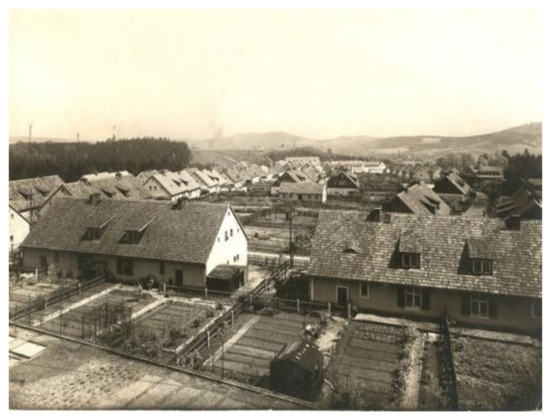
Figure 14.
Home gardens in Stadparksiedlung in the first years of development. Adapted with permission from collection of Historical Department of the Museum in Wałbrzych (Muzeum Porcelany w Wałbrzychu, Oddział Historyczny) 2507.
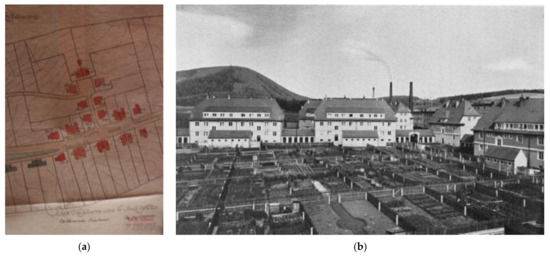
Figure 15.
(a) Fragment of the project of the housing estate in Sandberg. Reproduction without scale. Adapted with permission from collection of Communal Archives in Szczawno (Archiwum gminy Szczawno), 65/103, s. 62, Errichtung von 25 Bergmannshaeusern, Lageplan Klein Siedlung Ober-Salzbrunn, M. 1:1000, der Ausführende Wilhelm Kahmann, Bad Salzbrunn 4 July 1920. (b) Central square with workers’ gardens in Friedenhof Siedlung in Weiβstein in archival photography from the mid-twenties of the 20th century. Adapted from [43] (p. 98) (public domain) https://dbc.wroc.pl/dlibra/publication/17186/edition/15270 (accessed on 7 January 2021).
To a large extent, the functional solutions of the settlements had to be derived from the layout of rural houses, as the population was usually comprised of first-generation migrants from the countryside. The idea of a house with a garden for each family, derived from Howard’s theory and implemented by Unwin (in whose studio May worked during his internship in England), was a response to social needs. In earlier periods, the need to cultivate at least a piece of land was secured by providing each flat with a workers’ garden. In the projects of the Schlesische Heimstätte studio, both concepts were combined. In the early modernist housing settlements, gardens could have the character of agricultural facilities with a considerable area of 1500–2500 m2—as in the case of the housing settlement on Sandberg, which initially (similarly to the housing settlement in Goldschmiden (Złotniki in Wrocław)) was to be mainly rented to agricultural workers. In Gottesberg, each flat that was located in the first row of two-story single and semi-detached buildings with single-story connectors was provided with a large garden (450 m2) behind the buildings and with sheds in the connectors between the houses [74]. In Stadtparksiedlung, gardens varied in size (200–500 m2), and in the Nieder Sobięcin settlement, the differences were more significant depending on the type and location of buildings (130–350 m2). Most often, the size of plots exceeded 200 m2, as in the settlements in Rothenbach (200–300 m2) or Dittersbach–Neuhäuser Siedlung (200–300 m2). The smallest were plotted for multi-family housing settlements in Melchior Siedlung (100–150 m2) and Gottesberg (70 m2), while in Weiβstein, they slightly exceeded 50 m2. The plots were carefully planned and enclosed with fences. This created checkered or fan-shaped green arrangements. In the gardens, the outbuildings—that were designed together with the remaining buildings in many housing settlements (e.g., in Dittersbach, Weiβstein, and Konradsthal)—were erected. Vegetables and flowers were grown. In most settlements, poultry and even domestic animals were also kept. However, in some cases, it was strictly forbidden even to have dovecotes (Nieder Hermsdorf). The attachment to this form of contact with nature and relaxation after working hours is evidenced by the fact that the probably planned green spaces in the housing settlement Hartebusch, as in all previous Jansen projects, were parceled and changed into gardens; the same happened at the end of the 1920s and 1930s (in the Waldenburg agglomeration, only two pre-war housing settlements had public green spaces).
Attempts were also made to ensure an attractive appearance, a good level of care of gardens, and an increase in production efficiency. These goals were achieved by establishing companies that promoted knowledge in the field of gardening and publishing magazines addressed to users of small home and working gardens [16,75].
Home and working gardens became the most important characteristics of the housing estates of that period. They provided for the needs of the population from the countryside who were accustomed to cultivating the land and keeping domestic animals. Such facilities also sought to establish social habits. The need to ensure stress-relieving recreation for the miners, which had been fulfilled by visits to taverns or handicrafts (e.g., hosiery making in the Waldenburg region), could be replaced by gardening. It also had an economic aspect, simply supplementing the inhabitants’ diet and raising the general level of nutrition, which turned out to be particularly important in the period of the “great crisis.” It was also important to transfer some of the work of cleaning and developing the estate to the residents. This could have decisively accelerated the process and rapidly improved the natural qualities of the housing area.
5. Discussion
The specific location of the Waldenburg agglomeration settlements in the mountains imposed unusual solutions, but their creators—prominent German architects of that time like Hermann Jansen, Ernst May, Theo Effenberger, and Ernst Pietrusky or architects associated only with this city like Oscar Rogge—introduced certain principles that were later adopted as the basis for planning housing complexes. This basis also referred to the design of green spaces in housing settlements. Greenery systems were used both as elements of urban composition and as recreational facilities. In the new housing settlements, along with the regulation of streets, carefully considered planting was introduced—mainly rows of lime, maple, and chestnut trees. Traditional solutions of roads in the form of alleys, an early modern idea that was popularized in Germany in the urban planning handbook by Joseph Stübben at the turn of the 19th and 20th centuries, were preserved. The idea of the square as an element that highlights compositional nodes was also taken up. This form of introducing urban greenery, developed at the turn of the 17th and 18th centuries, started to appear in plans of new residential districts of Silesian cities from the beginning of the 19th century and gained popularity in the Art Nouveau era. In early modernist solutions, this form took a slightly different form. In Jansen’s design, it took the shape of small park complexes (perhaps due to the need to preserve the old trees). In the concepts of Ernst May and other architects associated with the Schlesische Heimstätte, squares were transformed into green squares at street intersections and much larger central housing settlement squares where the most important services were concentrated. From these skillfully used traditional forms, the designers created a complete housing estate green system. It became an element of the entire urban concept.
Just as the architecture and urban planning of these housing complexes were based on studies of the local development, the same approach was followed for the shaping of green spaces. The studies respected the local natural and cultural landscape. Inspiration was sought in the immediate surroundings of the designed area, and attempts were made to interpret the rules governing nature and the local community. In this way, the settlements gained coherence with their surroundings and an effect of spontaneity in the urban arrangements. Care was given to monuments of nature, e.g., oaks and beeches in Hartebusch Siedlung, yew trees in Nieder Hermsdorf, and the historic alley leading to Neuhaus. The designs of greenery layouts skillfully applied the principle of quotation, i.e., the literal imitation of traditional solutions and prudent stylization (e.g., in urban planning, it was the use of an oval center and in architecture, it was the use of semi-circular passages, dormers of the “oeil de boeuf” type, classical cornices, etc.) in the form of a line of village buildings along a stream (Sandberg), a kind of a village green, a green square analogous to a common village grassland (Stadtparksiedlung), a manor courtyard (the housing settlements in Weiβstein), rural roads with scattered buildings interwoven with short rows of trees, and tree-lined street bays (the housing settlements in Gottesberg and Dittersbach). New forms were introduced based on distinguished, traditional compositional rules (in urban planning, this means a layout with a dominant height and space, as well as a different choice of building density; in architecture, this means diversified proportions of window sizes and shapes), such as green squares at the intersections of streets and pedestrian alleys (Stadtparksiedlung) or in the middle with Unwinian cul-de-sacs (Sandberg), as well as attractive semi-circle or horseshoe layouts of buildings surrounded by greenery that were inspired by English baroque and classicist crescents (the Dittersbach housing settlements and the unrealized settlement on Gleisberg in Waldenburg–Parkowa Góra in Wałbrzych). Careful attention was also paid to the arrangement of household and workers’ gardens. Their attractiveness in the landscape was determined by the skillful division of land (which mirrored the parceling out of the villages surrounding Waldenburg) and well-designed garden architecture that replicated regional forms used in residential buildings, and it was sometimes enriched with traditional woodcarving decorations and well-tended crops (for this purpose, an advisory magazine was published). Home and working gardens were of particular social and economic importance. Their creation was part of a deliberate program to create a lifestyle for the residents of the estate, based largely on tradition and habit.
In the early modernist housing estates of the Walbrzych region, the designed greenery layouts were considered not a supplementary decorative element but one of the most important components of a complex urban and architectural design. These were not the first applications of greenery systems in this character. Already in the designs of neo-Baroque and (especially) Art Nouveau districts, greenery compositions constituted an important factor shaping the space. However, it was not until the housing estates of early Modernism (among which the Waldenburg estates are among the first) that the shaping of greenery was so comprehensively included in the functional, ideological, and formal concepts and the social program. Greenery compositions arranged main squares and streets of residential complexes. They fundamentally shaped the landscape character of entire complexes. Parks and squares constituted recreational background, where entertainment and, in time, sports facilities were located. The cultivation of employee and home gardens became a way of spending free time. The culture of spending time outdoors in green surroundings was promoted.
6. Conclusions
The greenery in early modernist housing estates in the Waldenburg agglomeration has survived to the present day. Public green areas, maintained and partly replaced, are attractive recreational areas of the housing estates (See Appendix A, A11). They are also objects of interest and pride for the inhabitants [76,77,78]. Attractive panoramas and views of housing estates and districts of Walbrzych and neighboring towns are admired because they have been revalorized in recent years through the restorations of viewpoints and the shaping of chaotically overgrown vegetation. Home and working gardens are in constant use. Their presence makes the housing offer of the still-exploited modernist housing estates around Waldenburg particularly attractive.
The green system of these housing estates is still one of the best-designed systems and may still be a model for contemporary developers of urban plans for residential complexes. The introduction of avenues and espaliers and the arrangement of green squares and plazas are worthy of imitation or, at least, of inspiration. Additionally in terms of solving household and working gardens (which are probably becoming popular again after a period of certain loss of attractiveness), the ideas from the 1920s implemented in this area may still prove valuable. The most valuable, however, is probably the very approach to solving design issues while considering broad social needs. This was based on both the implementation of modern ideas in architectural and urban planning concepts, including the planning of green areas in housing estates, and on respect for tradition in the customs and functioning of local communities. In the city landscape and in the urban interiors of new settlements, a sense of the introduction of new values was created, but this was in line with the principles that had long been present in the area.
Funding
This research received no external funding.
Institutional Review Board Statement
Not applicable.
Informed Consent Statement
Not applicable.
Data Availability Statement
The study did not report any data.
Conflicts of Interest
The author declares no conflict of interest.
Appendix A
A1: Apart from the first effects of the economic crisis in Germany, a fundamental change in the design of housing settlements was brought about by the centralization process in the operation of housing companies, which began in this very year. The laws on housing issues have also been fundamentally changed.
A2: A movement supported by the state since 1919, the Kleingarten Law of 1919 and 1920, and the Heimstätterecht Law of 1920. The laws of 1920 and two of 1924 recommended the establishment of settlements with large gardens (Heimstättesiedlung) and gave rise to organizations for such investments (Heimstätte).
A3: The Schlesisches Heim (Schlesische Heimstätte) with the seat in Breslau was founded on 28 July 1919 as the fourth such regional organization. The first was established in Westphalia in 1918, and the last was established in 1925 in Upper Silesia.
A4: Ernst May (1886–1970) studied in England, where he later served his apprenticeship in the studio of Raymond Unwin, and then he studied in Munich. After the First World War, in which he actively participated, he started working in Breslau. He became the technical director of the Schlesisches Landgesellschaft and later of the Schlesische Heimstätte. He took part in the competition for the development plan of Breslau, promoting the idea of satellite settlements. In 1925, he became the head of the municipal building office in his hometown Frankfurt am Main. He drew up a development plan, and, until 1930, he designed or participated in the design of successive housing settlements of the so-called “New Frankfurt.” He left for the USSR, where he led a group of architects working on concepts for large housing settlements in Moscow and new cities (Magnitogorsk, Stalinsk, and Nizhni-Tagil). In 1934, he emigrated to Africa. There, he developed both urban and architectural projects for monumental buildings. In 1954, he returned to Germany to Hamburg.
A5: New dwellings built in the Waldenburg agglomeration: in 1924, there were 171 (83 private and 88 communal); in 1925, there were 350 (143 private and 207 communal); in 1926, there were 416 (174 private and 242 communal); and in the middle of 1927, there were 370 (140 private and 230 communal).
A6: Particularly among the notes drawn during the honeymoon trip around Waldenburg. Note in the collection of the Museum in Frankfurt, exhibited during the Ernst May exhibition in the Museum of Architecture in Wrocław.
A7: Hermann Jansen (1869–1945)—a lecturer at the Berlin and Stuttgart universities of applied sciences, specialist in urban planning and housing design, member of the Berlin city council, official in the ministry, and member of the Prussian Academy of Arts from 1918—was the author of numerous urban general and detailed designs. Probably the most important of them was a general plan for Berlin (first prize in a competition organized by the city council in 1910), followed by designs for Berlin districts (Treptow in 1914, Western Berlin in 1917, and Charlottenburg in 1919) and other German towns (Cologne, Leipzig, Schleswig, Nürnberg, Brandenburg, Wiesbaden, and the Enden–Friesland housing settlement in 1915). He also prepared numerous housing settlement projects for Pomeranian towns (Koszalin, Stargard, and Szczecin) and Silesian towns (now: Nysa, Brzeg, Środa, Złotoryja, Świdnica, Bierutów, Namysłów, and Ząbkowice). He developed projects of districts in Łódź, Riga, Budapest, Constantinople, and Ankara. He commented on small housing settlements (1909), as well as blocks of flats (1910 and 1917) and large cooperative settlements (1910). He was also the author of large architectural buildings such as the Great Market Hall in Berlin (1915).
A8: Ernst Pietrusky, after studying in Breslau, was active during the last years of the war in Goldap (Gołdapia), starting his architectural career with a project for a housing settlement in Nieder Hermsdorf. Then, he was engaged as an architect and town planner in Waldenburg and its surroundings. He designed buildings in modernist style, e.g., the Labor Office and a school in Weiβstein. He also designed several other schools in Lower Silesia, e.g., Hans-Schemm-Schule in Glatz (Kłodzko) and the airport in Gandau (Gądów in Wrocław).
A9: Otto Rogge (1866–1955): in 1910, he became the town building master of Waldenburg. Then, in 1924, he became the town building advisor. He prepared numerous urban and architectural projects in Waldenburg. He planned the expansion of districts and housing settlements, e.g., on the slopes of Gleisberg and Neustadt (from 1927). He designed many public buildings—the Evangelical Lutheran church, numerous schools (e.g., the Catholic school in Altwasser, the Municipal Female Vocational and Trade School, and the comprehensive secondary school in Neustadt (1928)), the sports stadium with a swimming pool in Neustadt (1926), the management board building of the Municipal and District Health Fund (1930), and the communal cemetery in Altwasser.
A10: Theo Effenberger (1882–1968) studied in Breslau and later in Darmstadt. After working in Magdeburg and Augsburg, he returned to Breslau in 1907. In 1910, he was one of the co-founders of the Silesian Association for the Protection of Heritage (Heimatschutzbewegung). From 1919, he mainly worked for Siedlungsgesellschaft Breslau A.G., designing several housing settlements and housing complexes, including the aforementioned Pöpelwitz (1919–1927) and Westend and Viehweide (1925–1929).
A11: This—a separate problem, also in terms of preserving the landscape and functional values of greenery—concerns housing estates whose urban structures have been destroyed by a transit route. This was the case for two of the complexes in question—in Melchior Siedlung in the 1970s and 1980s, as well as in the other Hartebusch Siedlung at the present time.
References
- Piccinato, G. La Costruzione Dell’urbanistica; Officina Edizioni: Roma, Italy, 1974. [Google Scholar]
- Collins, G.R.; Crasemann Collins, C. Camillo Sitte and the Birth of Modern City Planning; Phaidon Press: New York, NY, USA, 1965. [Google Scholar]
- Wilhelm, K. Städtebautheorie als Kulturtheorie, Camillo Sittes „Der Städtebau nach seinen künstlerischen Grundsätzen“. In Cultural Turn. Zur Geschichte der Kulturwissenschaften; Musner, L., Wunberg, G., Lutter, C., Eds.; Turia & Kant: Vienna, Austria, 2001; pp. 89–109. [Google Scholar]
- Speitkamp, W. Die Verwaltung der Geschichte: Denkmalpflege und Staat in Deutschland 1871–1933; Vandenhoeck & Ruprecht: Göttingen, Germany, 1996; pp. 36–65. [Google Scholar]
- Castex, J.; Depaule, J.C.; Panerai, P. Formes Urbaines: De l’ilot a’ la Barre; Dunod: Paris, France, 1977; p. 45, et. seq. [Google Scholar]
- Posener, J. Berlin auf dem Wege zu Einer Neuen Architektur, Das Zeitalter Wilhelms II; Prestel Verlag: München, Germany, 1979. [Google Scholar]
- Heinrich, E.; Ernst, W. Berlin und Seine Bauten, Volume 2, Rechtsgrundlagen und Stadtentwicklung; Ernst, W. & Sohn: Berlin, Germany, 1964. [Google Scholar]
- Barnstone, D.A. Style Debates in Early 20th-Century German Architectural Discourse. Archit. Hist. 2018, 6, 17. [Google Scholar] [CrossRef]
- Battisti, L.; Pille, L.; Wachtel, T.; Larcher, F.; Säumel, I. Residential Greenery: State of the Art and Health-Related Ecosystem Services and Disservices in the City of Berlin. Sustainability 2019, 11, 1815. [Google Scholar] [CrossRef]
- Jackisch, B.A. The Nature of Berlin: Green Space and Visions of a New German Capital, 1900–45. Cent. Eur. Hist. 2014, 47, 307–333. [Google Scholar] [CrossRef]
- Zachariasz, A. Modernizm w kształtowaniu ogrodów i terenów zieleni—Przyczynek do historii architektury krajobrazu w Polsce. In Architektura Pierwszej Połowy XX w. i Jej Ochrona w Gdyni i w Europie; Sołtysik, M.J., Hirsch, R., Eds.; Urząd Miasta: Gdynia, Poland, 2011; pp. 143–150. ISBN 978-83-907114-9-2. [Google Scholar]
- Walker, M. Zieleń w osiedlach i koloniach robotniczych. In Historyczne Osiedla Robotnicze; Bożek, G., Ed.; Śląskie Centrum Dziedzictwa Kulturowego: Katowice, Poland, 2005; pp. 70–76. [Google Scholar]
- Andrzejewska, A. Modernistyczni mistrzowie urbanistyki jako prekursorzy współczesnego trendu “zielonej infrastruktury” i “urban garden” w kontekście zachodzących procesów przestrzennych. Architectus 2019, 60, 53–65. [Google Scholar]
- Hilbrandt, H. Everyday urbanism and the everyday state. Negotiating habitat in allotment gardens in Berlin. Urban Stud. 2019, 56, 352–367. [Google Scholar] [CrossRef]
- Lieske, H. Self-Sufficiency in Suburban Home Gardens? On the History and Prospects of the Idea of Food Production in German Home Gardens. In Proceedings of the II International Conference in Landscape and Urban Horticulture, Bologna, Italy, 9–13 June 2009; Gianquinto, G.P., Orsini, F., Eds.; Humana Press: Totowa, NJ, USA, 2010; Volume 881, pp. 807–812. [Google Scholar]
- Urbanik, J. Krajobraz nowoczesnych osiedli okresu międzywojennego w Niemczech w dziełach Leberechta Migge. In Architektura Pierwszej Połowy XX w. i Jej Ochrona w Gdyni i w Europie; Sołtysik, M.J., Hirsch, R., Eds.; Urząd Miasta: Gdynia, Poland, 2011; pp. 35–42. ISBN 978-83-907114-9-2. [Google Scholar]
- Gryniewicz-Balińska, K. Historyczne ogrody działkowe Wrocławia jako element planowego systemu zieleni miejskiej. Kwart. Archit. Urban. 2015, 60, 45–56. [Google Scholar]
- Ludwig, B. Osiedla Mieszkaniowe w Krajobrazie Wałbrzyskiego Okręgu Górniczo-Przemysłowego (1850–1945); Oficyna Wydawn; Politechniki Wrocławskiej: Wrocław, Poland, 2010; pp. 584–586. ISBN 978-83-7493-573-9. [Google Scholar]
- Dobesz, J. Hans Poelzig i Wrocławska Akademia Sztuki. In Ten Wspaniały Wrocławski Modernism; Loose, S., Ed.; VIA: Wrocław, Poland, 1991; pp. 14–26. [Google Scholar]
- Niemczyk, E. Architektura Wrocławia pocz. XX w. a problem kontynuowania tradycji miejscowych. In Wątki Kulturowe i Symboliczne w Architekturze Współczesnej; Oficyna Wydawn; Politechniki Wrocławskiej: Wrocław, Poland, 1980; pp. 61–74. [Google Scholar]
- Howard, E. To-Morrow. A Peaceful Path to Real Reform; Swan Sonnenschein & Co.: London, UK, 1898. [Google Scholar]
- Howard, E. Garden Cities of To-Morrow; Swan Sonnenschein & Co.: London, UK, 1902. [Google Scholar]
- Tomaszewicz, A. Osiedle Borek—historia i architektura (1871–1914). In Przedmieście Świdnickie we Wrocławiu; Okólska, H., Górska, H., Eds.; Muzeum Miejskie Wrocławia Wydawnictwo GAJT: Wrocław, Poland, 2012; pp. 98–110. [Google Scholar]
- Kononowicz, W. Urbanistyczny rozwój Wrocławia od połowy XIX wieku do II wojny światowej. In Wrocław; Atlas Historyczny Miast Polskich; Śląsk, Issue 13; Instytut Archeologii i Etnologii PAN: Wrocław, Poland, 2017; Volume IV, pp. 15–22. ISBN 978-83-63760-82-3. [Google Scholar]
- Ludwig, B. Nowe Miasto w Wałbrzychu jako przykład przenikania idei secesyjnych do urbanistyki Josepha Stübbena. Kwart. Archit. Urban. 2009, 54, 66–77. [Google Scholar]
- Neisse: Ein Führer durch die Stadt und ihre Geschichte; F. Bär: Neisse, Germany, 1922; p. 37.
- Störtkuhl, B. Modernizm w Legnicy; Muzeum Architektury we Wrocławiu: Wrocław, Poland, 2007; pp. 12, 60. [Google Scholar]
- Migge, L. Jedermann Selbstversorger; Lugen Dederichs: Jena, Germany, 1918. [Google Scholar]
- Haney, D.H. Leberecht Migge’s “Green Manifesto”: Envisioning a Revolution of Gardens. Landsc. J. 2007, 26, 201–218. [Google Scholar] [CrossRef]
- Tafuri, M. Sozialpolitik e citta’ nella Germania di Weimar. In La Sfera e il Labirinto; Tafuri, M., Ed.; Einaudi: Turin, Italy, 1980; pp. 243–293. [Google Scholar]
- Muthesius, H. Kleinhaus und Kleinsiedlung; F. Bruckmann: München, Germany, 1918. [Google Scholar]
- Siedlung. Der Grosse Brockhaus; Brockhaus: Leipzig, Germany, 1934; Volume VII, p. 382. [Google Scholar]
- Damschke, A. Heimstätterecht. In Wasmuth Lexikon der Baukunst; Wasmuth: Berlin, Germany, 1931; Volume III, p. 82. [Google Scholar]
- Lemmer, L. Kleingarten. In Wasmuth Lexikon der Baukunst; Wasmuth: Berlin, Germany, 1931; Volume III, p. 377. [Google Scholar]
- Pauly, 10 Jahre Wohnungsfürsorgegesellschaften. Schles. Heim 1928, 9, 1.
- May, E. Leiter und Bauabteilung des Schlesisches Heim u. Schlesischen Landgesellschaft, Sielungspläne. Schles. Heim 1920, 1, 7. [Google Scholar]
- Effenberger, T. Siedlung und Stadtplanung in Schlesien. Volume 2, Ober u. Niederschlesien; Grass, Barth: Breslau, Germany, 1926; p. 9. [Google Scholar]
- Ernst May 1886–1970; Quiring, C., et al., Eds.; Muzeum Architektury: Wrocław, Poland, 2012; ISBN 9788389262660. [Google Scholar]
- Kononowicz, W. May Ernst. In Encyklopedia Wrocławia; Harasimowicz, J., Ed.; Wydawnictwo Dolnośląskie: Wrocław, Poland, 2000; p. 493. [Google Scholar]
- May, E. Siedlungspläne. Schles. Heim 1920, 1, 7–10. [Google Scholar]
- May, E. Klein Wohnungs Typen. Schles. Heim 1920, 1, 14–17. [Google Scholar]
- Ludwig, B. Ochrona wartości krajobrazowych w projektach osiedli autorstwa spółki „Schlesisches Heim” pod kierunkiem Ernsta Maya na Dolnym Śląsku. Kwart. Archit. Urban. 2011, 56, 3–22. [Google Scholar]
- Ohle, K. Der Kreis Waldenburg im Nieder-schlesischen Industriegebiet in Vergangenheit und Gegenwart; Korn: Breslau, Germany, 1927; p. 95. [Google Scholar]
- Rogge, O. Bau, Wohnungs-und Siedlungswesen. In Waldenburg; Stein, E., Ed.; Monographien deutscher Städte; Deutscher Kommunal-Verlag: Berlin-Friedenau, Germany, 1925; Volume XVI, pp. 93–95. [Google Scholar]
- May, E. Eine Bergarbeitersiedlung für Waldenburg. Schles. Heim 1920, 1, 3. [Google Scholar]
- Treuhandstelle für Bergmannswohnstätten in Niederschlesischen Steinkohlbezirk. Schles. Heim 1920, 1, 1.
- Hermann, J. Allgemeines Lexikon der Bildenden Künstler; Becker,, T., Ed.; E.A. Seemann: Leipzig, Germany, 1967; Volume XVIII, p. 398. [Google Scholar]
- Hermann, J. Wasmuths Lexikon des Baukunst; Wasmuth: Berlin, Germany, 1931; Volume III, p. 272. [Google Scholar]
- Stahl, F. Ernst Pietrusky; Ernst Hübsch Verlag: Berlin, Germany; Vienna, Austria, 1927. [Google Scholar]
- Rogge, O. Neubauten im Waldenburger Industriegebiet; Deutsche Architektur-Bücherei G.M.B.H.: Berlin, Germany, 1930; p. 9. [Google Scholar]
- Dobesz, J. Wrocławska Architektura Spod Znaku Swastyki na Tle Budownictwa III Rzeszy; Oficyna Wydawn; Politechniki Wrocławskiej: Wrocław, Poland, 1999; pp. 70–72, 105–106. [Google Scholar]
- Schlesischer Wettbewerb. Schles. Heim 1920, 1, 19.
- Protokoll der Sitzung des Preisgerichts … Siedlung Nieder Hermsdorf. Schles. Heim 1920, 1, 14.
- State Archives in Wrocław, Branch in Kamieniec Ząbkowicki (Kamieniec), Files of Sobięcin, 545–552.
- Pietrusky, E. Bergmannsiedlung Nieder-Hermsdorf, district Waldenburg. Schles. Heim 1925, 6, 379, et seq.. [Google Scholar]
- Grygiel, D. Pro Publico Bono. “Aktywność Państwa i Samorządu Miejskiego w Realizacji Obiektów Użyteczności Publicznej na Terenie Wałbrzycha w Latach 1856–1945. Ph.D. Thesis, University of Wrocław, Politechnika Wrocławska, Wrocław, Poland, 2019. [Google Scholar]
- May, E. Klein Wohnungs Typen. Schles. Heim 1920, 1, 14. [Google Scholar]
- State Archives in Wrocław, Branch in Kamieniec Ząbkowicki, Acta specialia der Magistrat zu Waldenburg, [117], Aufstellung des Bebauungsplanes für die Siedlung am Kreiskrankenhaus (Stadtparksiedlung).
- Postcard of Hermsdorf from 1932. Available online: https://polska-org.pl/4068894,foto.html?idEntity=565166 (accessed on 7 January 2021).
- Photo of Hermsdorf form 1911. Available online: https://polska-org.pl/3869460,foto.html?idEntity=547753 (accessed on 7 January 2021).
- State Archives in Wrocław, I/16482, Schlesisches Heimstätte, 1922–1925 , p. 88.
- May, E. Siedlungspläne. Schles. Heim 1920, 3, 8–11. [Google Scholar]
- Effenberger, T. Allgemeines Lexikon der Bildenden Künstler des XX Jahrhunderts; Vollmer, H., Ed.; E.A. Seemann: Berlin, Germany, 1931; Volume 2, p. 13. [Google Scholar]
- Nielsen, C. Theo Effenberger 1882–1968. Architect in Wroclaw and Berlin; Hänsel-Hohenhausen: Egelsbach, Germany, 1999. [Google Scholar]
- Ideen Wettbewerb. Schles. Heim 1920, 1, 18.
- May, E. Besiedlungspläne für hügeliges Gelände. Schles. Heim 1921, 2, 353. [Google Scholar]
- Krug. Die Bautätigkeit der Schlesischen Landgesellschaft in Kleinsiedlungssachen im J.1919. Schles. Heim 1920, 1, 11. [Google Scholar]
- May, E. Kleinsiedlung Ober Salzbrunn. Schles. Heim 1920, 1, 9. [Google Scholar]
- May, E. Typen für Mehrgeschossige Kleinwohnungsbauten. Schles. Heim 1920, 1, 9–12. [Google Scholar]
- May, E. Kleinsiedlung Dittersbach. Schles. Heim 1920, 1, 9. [Google Scholar]
- State Archives in Wrocław, Branch in Kamieniec Ząbkowicki, Akta m. Wałbrzych, 1955, Melchior Siedlung.
- State Archives in Wrocław, Branch in Kamieniec Ząbkowicki, Akta gminy Wałbrzych Główny, 390, s. 2, 3.
- May, E. Zweigeschossige Vier-und Sechsfamilien Wohnhäuser. Schles. Heim 1922, 3, 37–42. [Google Scholar]
- State Archives in Wrocław, Branch in Kamieniec Ząbkowicki, Spezial Acten Polizei Verwaltung zu Gottesberg, Bausachen, Schuetzenstr. 9.
- Siedlungs-Wirtschaft: Mitteilungen der Siedlerschule Worpswede. Die Grüne Illustrierte1923–1928, Volume 1–6. (Supplemente in Schlesisches Heim).
- Wałbrzych: Na Sobięcinie Rośnie Jedno z Najstarszych Drzew w Polsce. Available online: https://walbrzych.naszemiasto.pl/walbrzych-na-sobiecinie-rosnie-jedno-z-najstarszych-drzew-w/ar/c8-5132515 (accessed on 10 February 2021).
- Park im. T. Kościuszki w Wałbrzychu. Available online: http://www.pomniki-przyrody.pl/?p=4497 (accessed on 10 February 2021).
- Pomniki Przyrody w Wałbrzychu—Sobięcinie. Available online: http://www.pomniki-przyrody.pl/?p=4567 (accessed on 10 February 2021).
Publisher’s Note: MDPI stays neutral with regard to jurisdictional claims in published maps and institutional affiliations. |
© 2021 by the author. Licensee MDPI, Basel, Switzerland. This article is an open access article distributed under the terms and conditions of the Creative Commons Attribution (CC BY) license (https://creativecommons.org/licenses/by/4.0/).